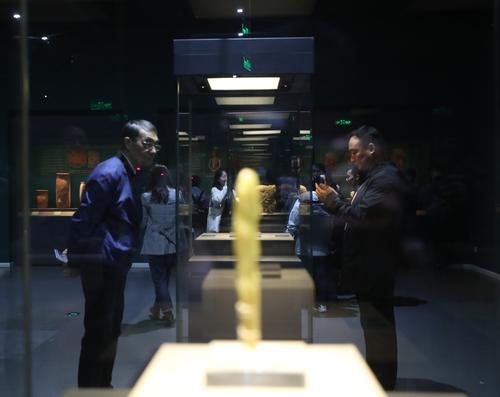The figure was excavated in 2015 at the Tari Yingzi site in Shara Town, Fuxin Mongolian Autonomous County, Liaoning Province, about 7500 years ago. After carbon 14 determination and expert research in recent four years, it is considered to be the earliest stone statue unearthed in China at present. The human face is the whole deification of human beings, so it is called the stone statue, which shows that the thinking concept of human sacrifice at that time has been very superb in the works of art.
For the stone statuel, Guo Dashun also said, "more importantly, it has fangs!" You see, there are fangs up and down here. What this fangtooth used to know is that in Hunan, Hunan it has a high temple culture, this high temple culture, in the Yuanjiang River Basin, this high temple culture is also about 7500 years ago, which is a little later than ours at the same time, and it, uh, later affected the Liangzhu culture in Jiangsu and Zhejiang areas, so the later jade gods and human faces of Liangzhu culture also have fangs. Later to Shijiahe culture, a little later, to about 4000 years, also out of a lot of people, but also have fangs. But this is the earliest thing. What's the relationship between them? Is it in the department? So far away. There is also a serrated thing outside its fangs, and the same is true at the high temple. It is even the same in detail, indicating that there is communication between them. So this is very powerful, so the land of China, ah, was no longer a normal primitive society at that time. We, Mr. Su Bingqi, call civilization the beginning of civilization and ten thousand years of civilization. It is not entering a civilized society, it is to prepare for that, China's ten thousand years of civilization started. "


This kind of tusked stone figure, previously collected in the right banner of bahrain, inner mongolia, but smaller and flaky. Linxi County Baiyin Changhan site also found a small stone head made of pyrophyllite grinding, engraved with eyes and mouth, mouth side also with clam pieces inlaid upper and lower fangs. The findings are also found in the south of the Yangtze River. In Hunan Gaomiao culture has found a number of pottery stamped grate tusks, also more than 7,000 years ago, but the lack of human face. After the Liangzhu culture and Shijiahe culture jade also sometimes carved fangs on the face of people found. It is known that this kind of tusked gods and people in Chahai - Xinglongwa Wen. The period of transformation has been to a certain extent universal, and has been continued by later generations. It shows that the land of China, from north to south, entered the "initial stage of civilization" from north to south, which is a prelude to the five thousand years of Chinese civilization.
Recently, at the "see Hongshan" fine cultural relics exhibition held in Liaoning, a stone statue of God was first met with the audience about 7500 years ago. This stone statue is a gray flint cuboid with a length, width and thickness of 9.2 cm, 5.17 cm and 3.05 cm. It is polished and smooth, with obvious and uniform outer arc on each side, and the edges are very sharp. The upper part of the front of the body is engraved with a negative engraving technique to carve a pattern centered on the human face, and the lower part is engraved with a horizontal line. Round eyes, long curved eyebrows, mountain nose, narrow flat mouth, upper and lower fangs on both sides of the mouth, double arc on the outside of the tooth, external arc with radiate long cusp process with external radiation, presumably abstract Transformed limbs. The pattern around the human face, one is that there are three serpentine "S" lines on each side of the upper part of the human face, the other is the inverted triangular ribbons arranged neatly in eight lines below the human face. The stone statue of God and man found in this study aims at highlighting the deification of human face. it is a masterpiece of art created by Ci ancestors under the more developed belief concept, which is strong in integrity and shallow in Yin engraving, but it has a three-dimensional sense.
Guo Dashun, who has presided over archaeological excavations of famous Hongshan cultural sites, such as Dongshanzui and Niuheliang, is known as the first person of "Hongshan Culture". "it is very important!" said Guo Dashun, who has presided over the archaeological excavation of famous Hongshan cultural sites. Why is it important? The first time it was early, it is now from 7500 to 8000. Once again, it is the deification of man as a whole, and it is called divine man (face). The deification of human beings shows that at that time, people already had quite a lot of ideas in the aspect of sacrifice, which was embodied in works of art. Because it is a shallow relief, the shade engraved very shallow, but you feel a kind of three-dimensional feeling, can not! "

(Picture Source:Sogou)




